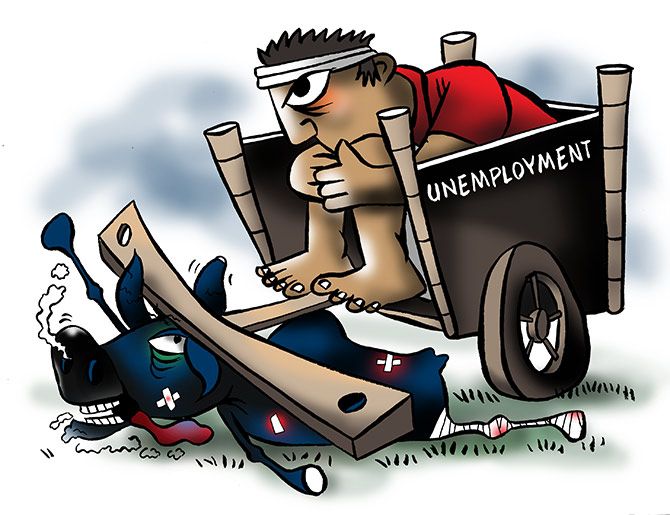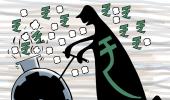'One of the biggest issues the Indian economy faces right now is of job creation...'
'The nexus between growth and employment has to be closed...'
'In the absence of a manufacturing expansion, the alternative is to have the service sector as the driver of both GDP as well as employment growth.'

Illustration: Uttam Ghosh/Rediff.com
"In the absence of any stimulus, we expect GDP to be 6.5 per cent for FY18. GDP growth could recover in FY19, but still remain below the potential growth rate," HDFC Bank Chief Economist Abheek Barua tells Rediff.com's Prasanna D Zore in an e-mail interview.
How would you explain the slump in the economic output from 9.1 per cent to 5.7 per cent in the last six quarters?
The decline in growth had actually started before the demo-shock hit the economy.
Undoubtedly, demonetisation and GST have hit economic activity, but they have also essentially exposed the vulnerabilities that were already plaguing the economy.
Some of these short and long term issues that have led to the slump in economic output include: For one, the favourable impact of lower oil prices has been fading since the beginning of 2016 (oil price are considerably higher than the lows reached in 2015).
Secondly, private consumption recovery has not been strong enough to push capacity utilisation rates up in the economy.
Rural consumption has remained especially fragile (given low trend growth in agriculture, slow wage growth, low crop insurance, inefficiencies in the procurement system).
Further, more structural issues of job creation have kept a tab even on urban consumption.
For example, the net increase in employees for close to 241 companies of the BSE 500 index slowed to 80,000 people in FY17 compared to 108,000 people in FY16.
Thirdly, investment growth fell to -2.1 per cent in Q4 FY17 from 6.9 per cent in FY13.
Consequently, bank credit growth has failed to take off despite the system being flush with liquidity.
The investment problem is both on the demand side (as capacity utilisation remains high) and the supply side (structural bottlenecks in land, labour, high NPAs etc).
Capacity utilisation rate for the economy has been declining over the last few years, especially for key manufacturing sectors such as cement, power and automobiles.
That said, even in sectors that have high CU (capacity utilisation) levels, the ability to attract fresh investments is restricted by overleveraged balance sheets.
Therefore, to sum it all, the decline in economic output in the last six quarters has been driven by a combination of shocks (such as demonetisation, disruptions due to GST), short term factors (oil price decline reversing, lack of a strong revival in private consumption etc), and mounting long term issues (lacklustre job creation, low growth in per capita incomes, slow progress in structural reforms).
Where would you peg the GDP growth at for the current fiscal year?
Overall factors that drove up growth during 2013, 2014 and 2015 are now losing momentum and are unlikely to provide the much needed push for growth.
On the positive side, as structural reforms undertaken by the government in the last three years -- namely, improve in ease of doing business, digitalisation, GST, etc -- kick in, growth could start seeing some support in the medium term.
In the short run, however, in the absence of any form of monetary or fiscal stimulus, GDP is likely to be close to current levels and we expect it to be 6.5 per cent for FY18.
In the medium term, GDP growth could recover in FY19, but still remain below the potential growth rate.
Would you subscribe to be the most dominant and the simplest narrative that the sudden drop in GDP numbers for the last two quarters were because of demonetisation and the random implementation of the Goods and Services tax?
There is some evidence to support the view that demonetisation has had a bigger impact on economic activity than anticipated earlier, especially on the cash intensive businesses (most of them being SMEs).
The transition from being cash based to digital has not been smooth and has caused disruptions in the system.
Just as the economy was beginning to recover from this first shock, the economy faced a second disruption -- the introduction of GST -- in Q1 FY18 and its inevitable teething troubles have affected supply chains, particularly the SME sector that was perhaps not entirely prepared for the new regime.
The niggles are being sorted out, but again the disruption could take longer than anticipated to resolve.
That said, a glance at GDP quarterly data shows that the loss in momentum had started even before these shocks hit the economy.
Demonetisation and GST have definitely accentuated the slowdown, but they are not the sole cause.
What do you see as the silver lining for the economy if you do believe that we are surrounded by the dark clouds of low job creation, placid non-food credit offtake and slack in exports?
The government has undertaken a number of reforms in the past three years such as improving the ease of doing business, removing bureaucratic red tape, started the process of cleaning up banks' balance sheet, implementation of GST, digitisation, and unburdening power discoms through UDAY among other things.
These reforms usually have an impact with a lag and are likely to provide the much needed support to growth in the coming quarters.
Also, a normal monsoon season this year is likely to push up rural consumption.

In the context of soft credit offtake, do you think the banks are nervous to lend given their capital inadequacies or are corporates shying away from risking capital in an environment where demand remains sluggish?
We think that both supply and demand side factors have contributed to the soft credit offtake in the economy.
We segregate the decline in credit growth into supply side, demand side, lending rates and other exogenous factors.
Our model suggests that of the 680 bps (100 basis points or bps = one per cent) decline in credit growth during Q2 FY14 and Q2 FY17, conversion of loans to UDAY bonds accounted for a 200 bps decline, demand side factors led to 300 bps decline and supply side factors including disintermediation were responsible for close to 250 bps fall in credit growth.
On the other hand, the decline in lending rates during this period supported credit growth, pushing it up by 70 bps.
Credit growth has remained low at 7.7 per cent (as of October 2017), although picking up slightly from its 60-year lows of sub-5 per cent readings in March 2017.
During November 2016 and March 2017, credit growth fell by as much as 4 percentage points.
After the remonetisation process started picking up pace, the improvement in credit growth was limited by the GST effect.
We expect the current pickup in credit growth to continue as the disruptions due to demonetisation and GST fade away.
Also, as the impact of UDAY bond issuances fades post FY18 and the transmission of RBI's rate cuts seeps in further, credit growth could see some more upside.
However, a more sustainable increase in credit growth will require an increase in demand and capacity utilisation rates for a rise in fresh investments and a decline in GNPAs in the banking system.
Can the Rs 2.11 lakh crore bank recapitalisation stimulus by the government give more confidence to the banks to shirk off their lethargy and begin lending for productive purposes and creation of assets?
So far banks have been reluctant to recognise their losses as it would hurt their capital ratios.
Lower capital ratios also meant that it was difficult for them to raise resources from the market in an economical way.
Now with recapitalisation of these banks, they would be nudged to recognise their losses, would be willing to take haircuts on stressed assets and clean their balance sheets, in turn reviving fresh lending.
Further, the banks are likely to witness valuation gains because of this exercise.
This might come in handy later on when these banks try to raise resources themselves (by selling equity) in the market (with regards to the final tranche of raising Rs 580 billion by banks).
Do you believe the government will not breach the fiscal deficit gap at 3.2 per cent of the GDP that it has aimed for the fiscal year 2017-2018?
There is a growing belief that the ongoing (economic) slump is not transient and that the economy really needs a booster shot.
There are others who believe that macroeconomic stability is the need of the hour and that the government cannot risk breaching its fiscal deficit target.
At the current run rate, fiscal slippage is tracking at around 0.3 per cent to 0.4 per cent of the GDP.
I believe that the government will give more weightage to fiscal prudence and exercise the various expenditure pruning and revenue raising options to adhere to the 3.2 per cent target.
While capex could be maintained at high levels, the required cut in expenditure could come on the revenue side.
I also believe that the GST worries are misplaced to some extent and that compliance (collections) could pick up in the coming months, allowing the government to meet its fiscal target.
What worries underline the RBI's hawkish stance on cutting rates that the government as well as the industry is clamouring for?
Rising oil prices, fiscal worries and consequently concerns about additional market borrowings by the government, gradual tightening of global monetary conditions, farm loan waivers by (various Indian) states, and upside risks related to implementation of higher salary and allowances under the 7th pay commission awards (which primarily impacts the housing component of retail inflation) are some concerns that have not allowed the RBI to cut rates.
What would you prescribe for the economy to fire on all its cylinders?
One of the biggest issues the Indian economy faces right now is of job creation.
The employment challenge in India is about a low consumer base, low growth (relative to potential) and high inequality.
This in turn could feed back into the system and limit our growth potential.
Therefore, the nexus between growth and employment has to be closed.
India has a large and young population but we need to transform this pool into a higher demand base through employment. This is critical for an economy that is not innovation driven like the US.
In the absence of a manufacturing expansion, the alternative is to have the service sector as the driver of both GDP as well as employment growth.
One way out, we think, is to turn towards construction and services such as tourism, personal care, education and healthcare that can absorb significant amounts of low skilled labour.
With a focus on 1. pushing growth in labour intensive sectors and 2. skilling labour to get them absorbed in high skilled services, would help solve the labour puzzle.
Secondly, speeding up the process of cleaning up banks' balance sheet would help push credit growth and in turn bring in fresh investments in the system.
This would push up economic activity and incomes/demand in the economy.









